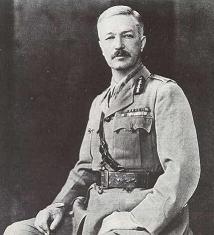
Colonel Reginald Edward Harry Dyer, was an officer of the Bengal Army and later the newly constituted British Indian Army. His military career began in the regular British Army but he soon transferred to the presidency armies of India.

Amritsar, historically also known as Rāmdāspur and colloquially as Ambarsar, is the second-largest city in the Indian state of Punjab, after Ludhiana. It is a major cultural, transportation and economic centre, located in the Majha region of Punjab. The city is the administrative headquarters of the Amritsar district. It is situated 217 km (135 mi) north-west of Chandigarh, and 455 km (283 mi) north-west of New Delhi. It is 28 km (17.4 mi) from the India-Pakistan border, and 47 km (29 mi) north-east of Lahore, Pakistan.

The non-cooperation movement was a political campaign launched on August 1, 1920, by Mahatma Gandhi to have Indians revoke their cooperation from the British government, with the aim of persuading them to grant self-governance.
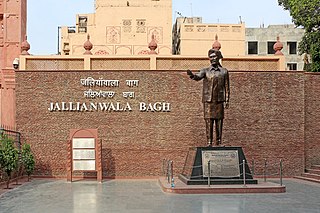
Jallianwala Bagh is a historic garden and memorial of national importance close to the Golden Temple complex in Amritsar, Punjab, India, preserved in the memory of those wounded and killed in the Jallianwala Bagh Massacre that took place on the site on the festival of Baisakhi Day, 13 April 1919. The 7-acre (28,000 m2) site houses a museum, gallery and several memorial structures. It is managed by the Jallianwala Bagh National Memorial Trust, and was renovated between 2019 and 2021.
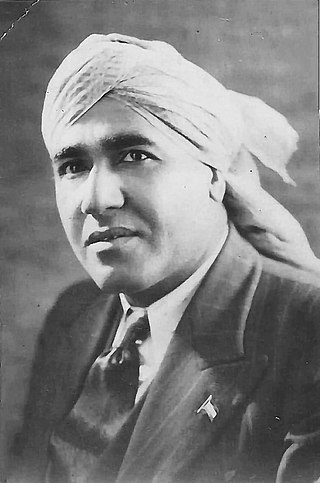
Udham Singh was an Indian revolutionary belonging to Ghadar Party and HSRA, best known for assassinating Michael O'Dwyer, the former lieutenant governor of the Punjab in India, on 13 March 1940. The assassination was done in revenge for the Jallianwala Bagh massacre in Amritsar in 1919, for which O'Dwyer was responsible and of which Singh himself was a survivor. Singh was subsequently tried and convicted of murder and hanged in July 1940. While in custody, he used the name 'Ram Mohammad Singh Azad', which represents the three major religions in India and his anti-colonial sentiment.

Sir Michael Francis O'Dwyer was an Irish colonial officer in the Indian Civil Service (ICS) and later the Lieutenant Governor of Punjab, British India, between 1913 and 1919.
Sunam is a town and a tehsil, near city of Sangrur in Sangrur district in the Indian state of Punjab. The Railway Station of Sunam was renamed as Sunam Udham Singh Wala.

The Jallianwala Bagh massacre, also known as the Amritsar massacre, took place on 13 April 1919. A large, peaceful crowd had gathered at the Jallianwala Bagh in Amritsar, Punjab, British India, during the annual Baishakhi fair to protest against the Rowlatt Act and the arrest of pro-independence activists Saifuddin Kitchlew and Satyapal. In response to the public gathering, the temporary brigadier general R. E. H. Dyer surrounded the people with his Gurkha and Sikh infantry regiments of the British Indian Army. The Jallianwala Bagh could only be exited on one side, as its other three sides were enclosed by buildings. After blocking the exit with his troops, Dyer ordered them to shoot at the crowd, continuing to fire even as the protestors tried to flee. The troops kept on firing until their ammunition was exhausted. Estimates of those killed vary from 379 to 1,500 or more people; over 1,200 others were injured, of whom 192 sustained serious injuries. Britain has never formally apologised for the massacre but expressed "deep regret" in 2019.

Anita Anand is a British radio and television presenter, journalist, and author.

The Indian Workers' Association (IWA) is a political organisation in Great Britain which consists of Indian immigrants to Britain and their descendants. IWA branches are organised in some major cities such as Birmingham and London. As one of the oldest and most active groups of immigrants, the organisation has been working in the fields of politics, race relations, industrial relations and social welfare, as well as many cultural issues. At the forefront of the struggle within trade unions, it has campaigned tirelessly against racism and on civil liberties issues.

Shaheed Uddham Singh is a 1999 Indian Punjabi-language biographical film based on the life of Udham Singh, an Indian revolutionary who had witnessed the 1919 Amritsar massacre and wanted to avenge the mass killing of his countrymen. He was desperate to punish Michael O'Dwyer, the Lieutenant Governor of the Punjab for his involvement with the massacre. The film was theatrically released in India on 24 December 1999, just two days before Singh's birth centenary. The film was screened retrospective on 13 August 2016 at the Independence Day Film Festival jointly presented by the Indian Directorate of Film Festivals and Ministry of Defense, commemorating 70th Indian Independence Day.
Jallian Wala Bagh is a 1977 Indian Hindi-language film written, produced and directed by Balraj Tah, with a screenplay by Gulzar. It is based on the Jallianwala Bagh massacre, also known as the Amritsar massacre, where in 1919 Colonel Reginald Dyer ordered troops under his command to fire into a crowd of unarmed Indian 379 civilians, killing.
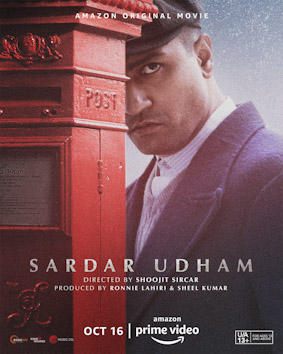
Sardar Udham is a 2021 Indian Hindi language biographical historical drama film directed by Shoojit Sircar, and produced by Rising Sun Films in collaboration with Kino Works. The screenplay is written by Shubhendu Bhattacharya and Ritesh Shah, with Bhattacharya also writing the story based on team research, and Shah also writing the dialogues, while playing a supporting role. Based on the life of Udham Singh, who assassinated Michael O'Dwyer in London to avenge the 1919 Jallianwala Bagh massacre in Amritsar, the film starred Vicky Kaushal in the title role, along with Shaun Scott, Stephen Hogan, Amol Parashar, Banita Sandhu and Kirsty Averton in supporting roles.
Sir Miles Irving CIE, OBE was an English Indian Civil Service officer. As Deputy Commissioner of Amritsar, the senior government official in charge, he transferred the city's administration to Colonel Reginald Dyer in April 1919, which helped to precipitate the Jallianwala Bagh massacre.
Satyapal was a physician and political leader in Punjab, British India, who was arrested along with Saifuddin Kitchlew on 10 April 1919, three days before the Jallianwala Bagh massacre.
Kim Ati Wagner is a Danish-British historian of colonial India and the British Empire at Queen Mary University of London. He has written a number of books on India, starting with Thuggee: Banditry and the British in early nineteenth-century India in 2007. He followed that up with a source book on Thuggee and has also written on the uprising of 1857 and the Amritsar massacre. A British citizen, Wagner feels an affinity for India.
Hans Raj was an Indian youth, in Amritsar, British India, who in June 1919 became an approver for the British government when he gave evidence for the Crown at the Amritsar Conspiracy Case Trial in which he identified his fellow Indian revolutionaries, buying his own freedom in return.
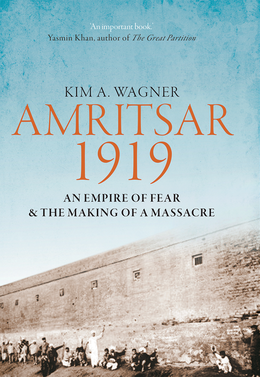
Amritsar 1919: An Empire of Fear and the Making of a Massacre (2019), is a book by Kim A. Wagner and published by Yale University Press, that aims to dispel myths surrounding the Jallianwala Bagh massacre that took place in Amritsar, India, on 13 April 1919.
Vishwa Nath Datta was a distinguished Indian writer, historian and professor emeritus at Kurukshetra University.
The Central Khalsa Orphanage, also known as the Central Khalsa Yatimkhana, is an orphanage for boys in Amritsar, India, established in 1904 by the Chief Khalsa Diwan. It is located on a plot of land covering five acres and has a secondary school, sports facilities, a home for the blind, a guest house, a library and a gurdwara. There is also a re-creation of the room of Indian revolutionary Udham Singh who, during some of his childhood and teens, resided at the orphanage.












